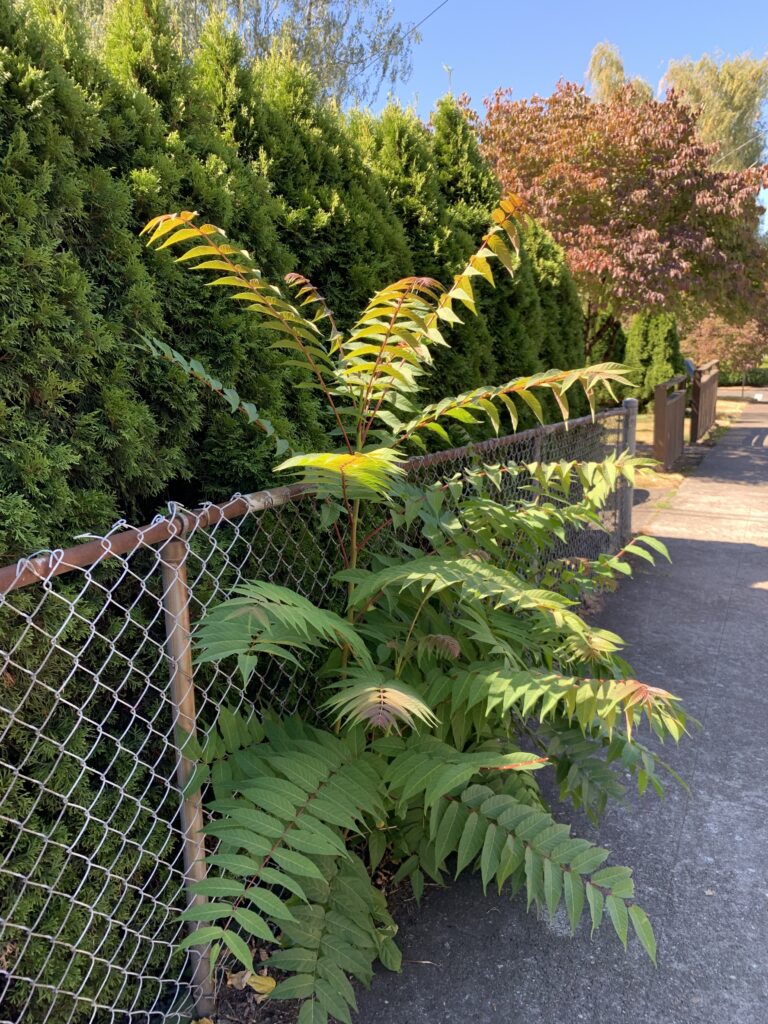
I have been fighting an enemy that continually sends in reinforcements and those reinforcements seem to pop up in all kinds of locations that are meant to ambush me. Locations that are hard to reach or they show up even stronger than before, attempting to break my will to fight them. I’m talking of course about the tree of heaven or Ailanthus altissima, or as I like to call it, the tree from hell. Go ahead, read up on this kryptonite of a tree, but if you don’t have time for that, here are some quick, important points about it.
- The tree of heaven crowds out native species and secretes a chemical into the soil that is toxic to surrounding plants.
- The tree’s aggressive root system can cause damage to pavement, sewers and building foundations.
- If the plant has matured, cutting alone will only help temporarily by reducing its ability to spread.
- The wood is useless. It is brittle and has no structural value and burns poorly.
- The cuttings smell like burning garbage.
Those are just a few of the issues with the tree of heaven. Really, it comes down to how easily it spreads and how quickly it grows. I can rip out the seedlings, getting all of the root, but more plants will show up in a week or so. If I give the plants more than a month, then their roots become established and it’s even harder to get rid of it. There are two full grown tree of heaven next door to our house in the exact disturbed soil that they so much love and they are constantly dropping seeds. On a windy day those seeds get carried all over the neighborhood and we’ll find seedlings growing on our evening walks. Some people let the seedlings grow because it looks like a tree, but they don’t understand that it is invasive. They don’t know that it spreads so fast it’s hard to control. Even in the image at the top of this post, there is another tree growing across the street from the mother tree. It spreads like a disease.
Unfortunately, the city of Portland has been somewhat reluctant to take fast action against the tree and they are popping up everywhere. Part of the issue is that the city says it’s a “nuisance” tree not “invasive”, even though a post on their website calls it invasive. Since the tree is a nuisance, it requires a paid permit to remove. This should be a case where the city sends a worker out, confirms it’s a tree of heaven and lets the trees removal occur without a permit. It’s going to cost property owners enough just to get them removed, and it’s not a single step process. Even with the tree cut down, there are multiple applications of chemicals needed to kill the root system and insure the plant doesn’t come back. The other option for the homeowner is that they let the tree grow and risk it causing physical property damage.
The big headache comes when a tree of heaven hits a sewer or water main. Only then does the city care about the tree and the problems it causes. There’s a train yard not far from our neighborhood and there swaths of trees of heaven covering parts of the yard. I would guess because it’s open area where wind can easily blow, they are one of the main spreader areas for the tree of heaven.
For my fellow Portlanders please give the city a call if you see one of these trees on city property; They are commonly on sidewalks next to power line poles and near fence lines. If you need help with the tree of heaven, you can also contact TenPDX.



